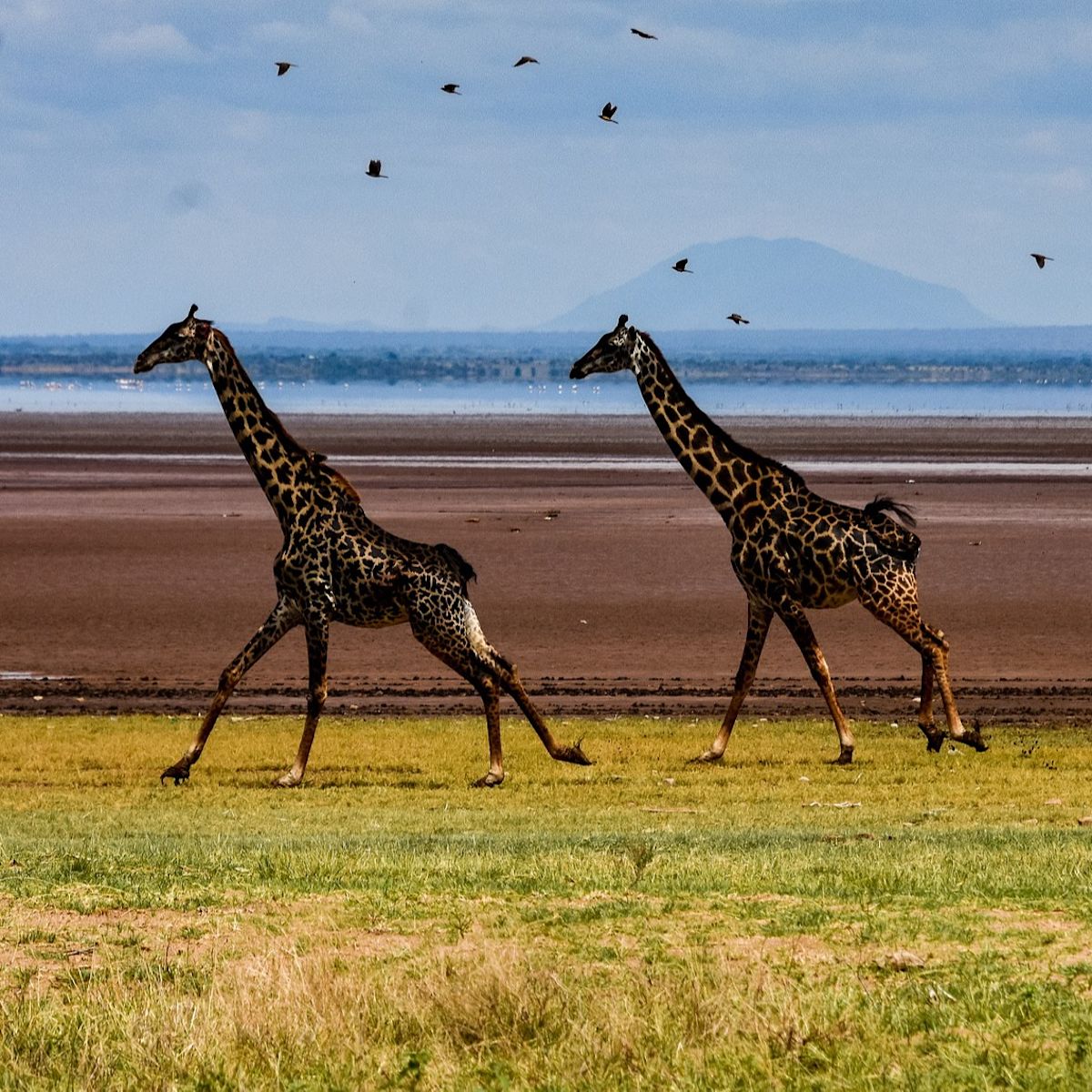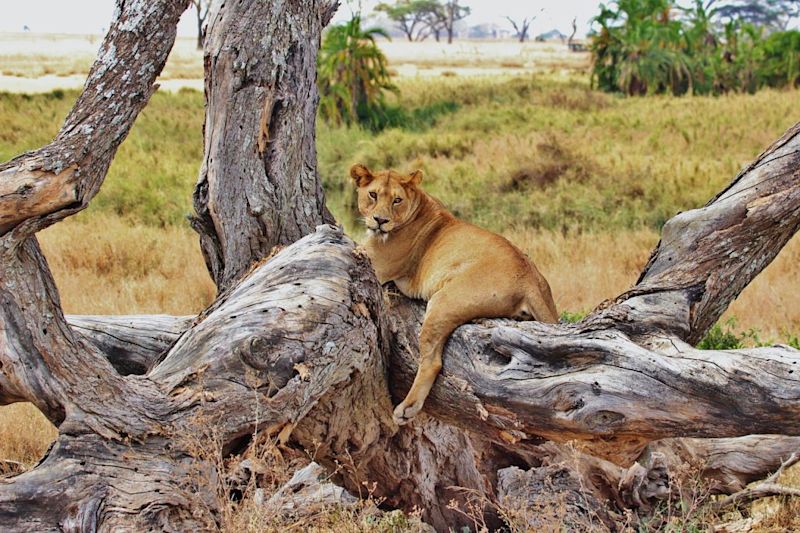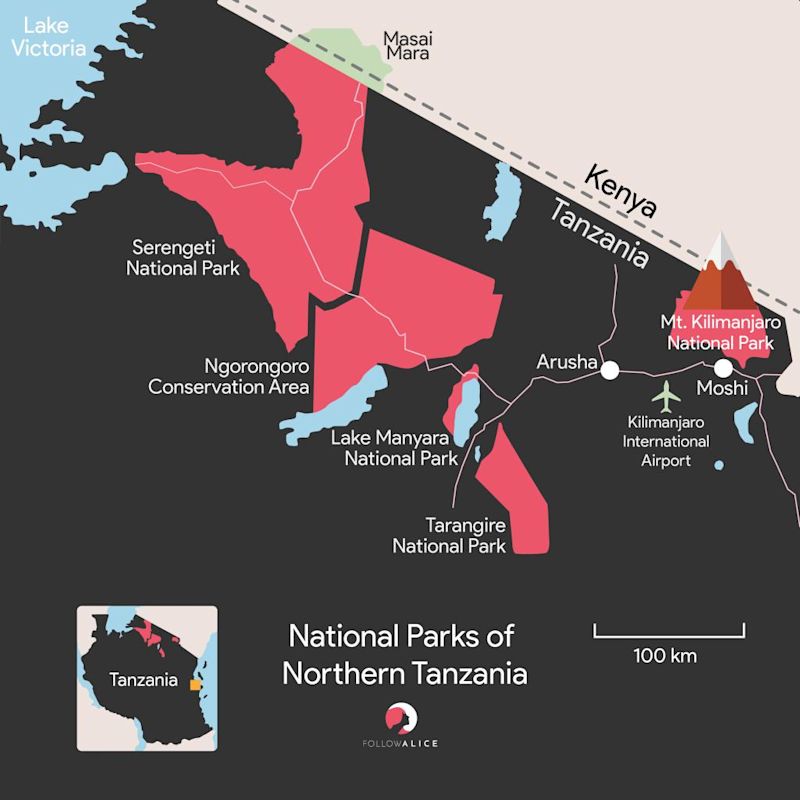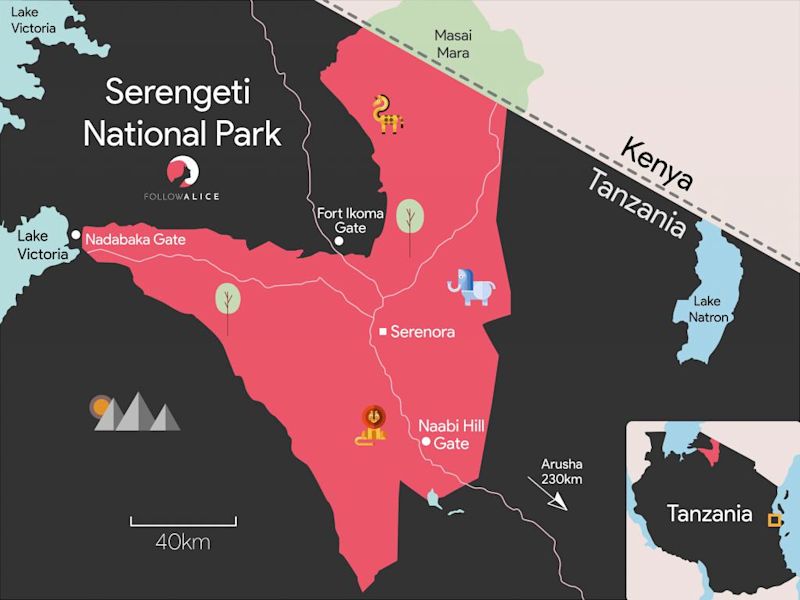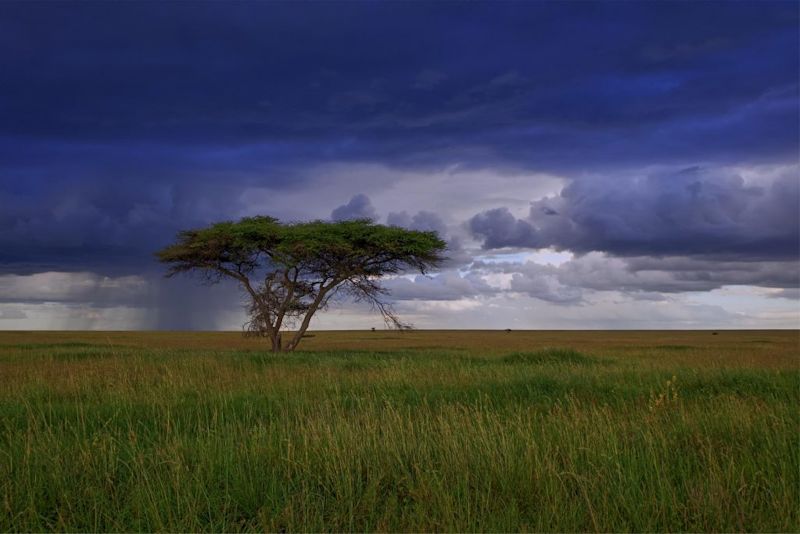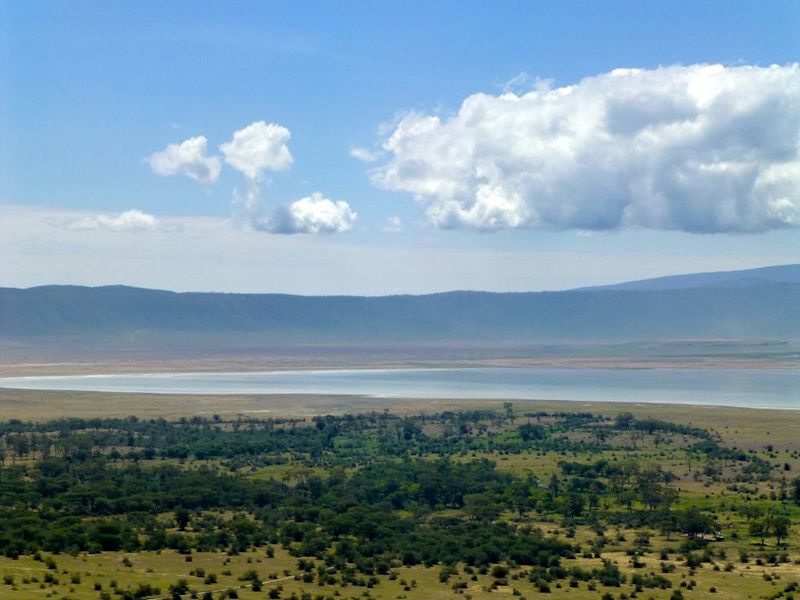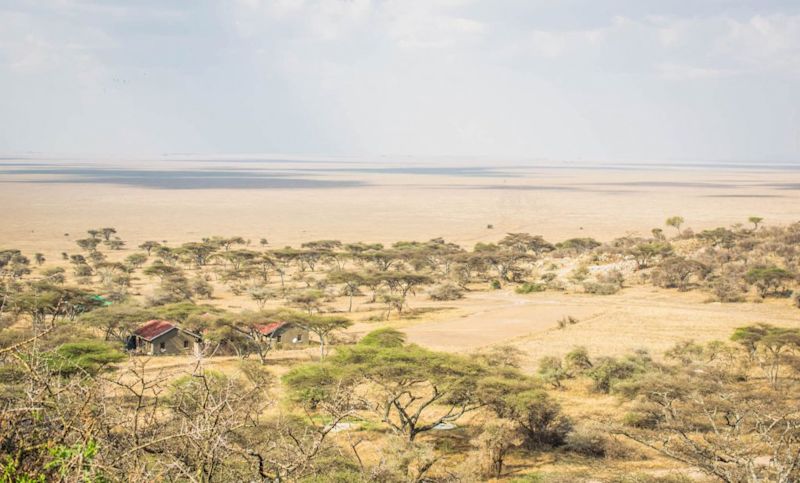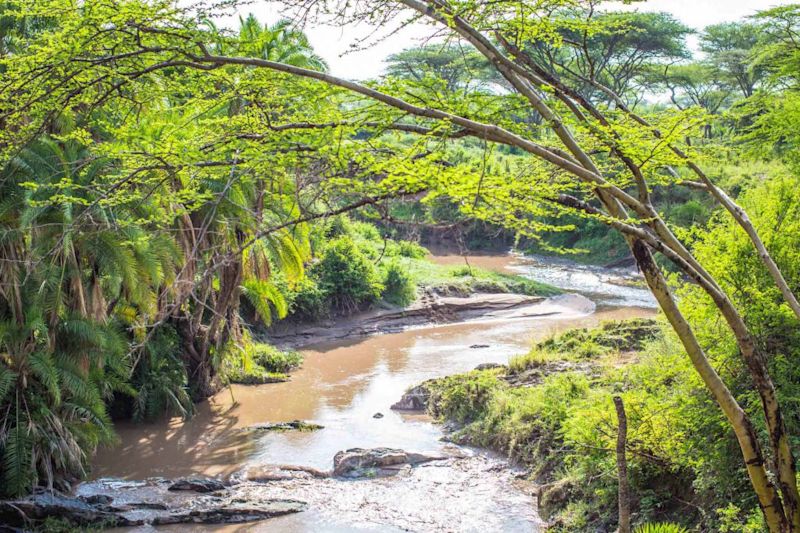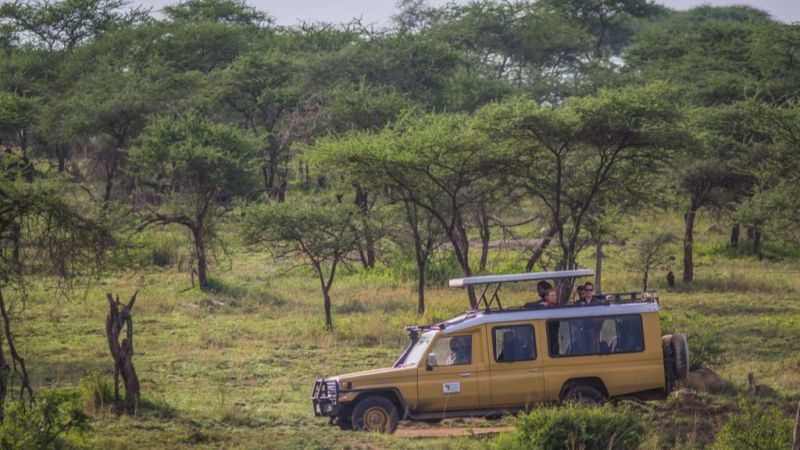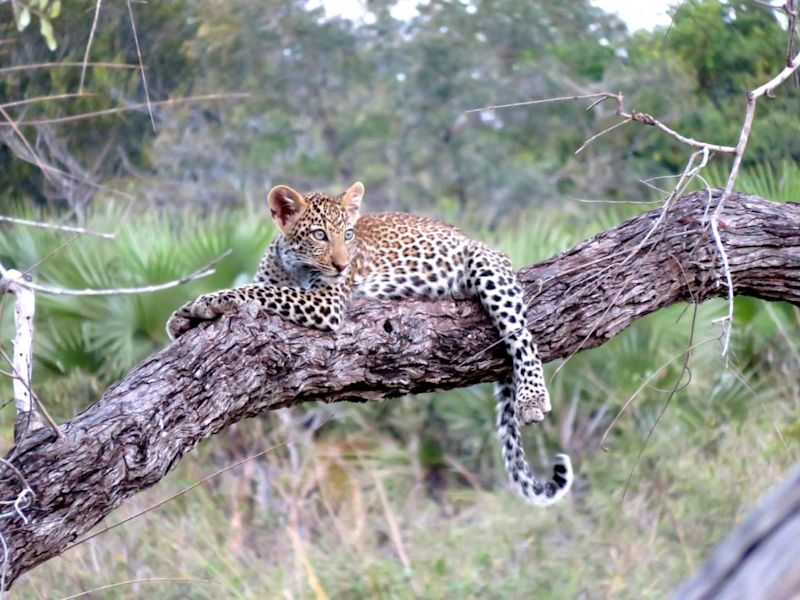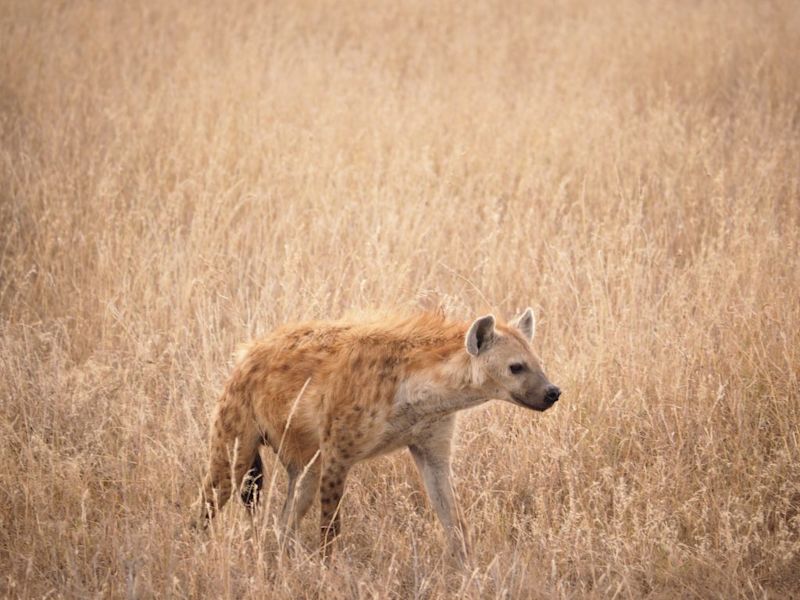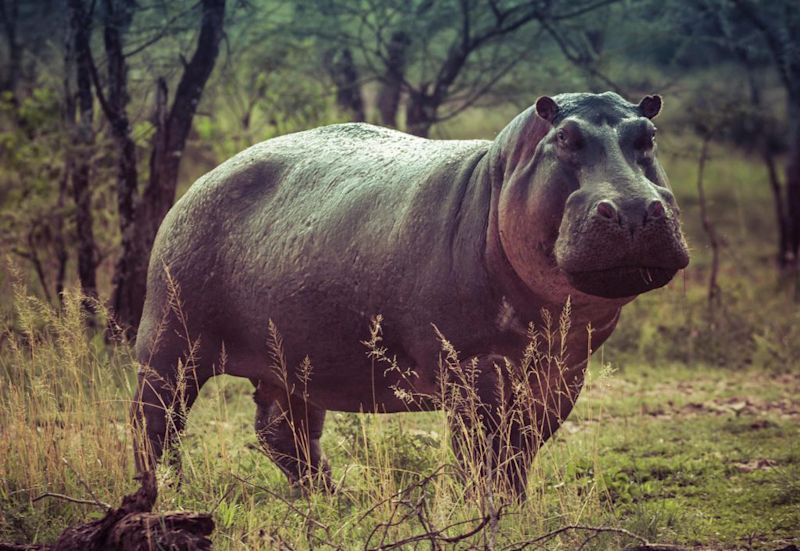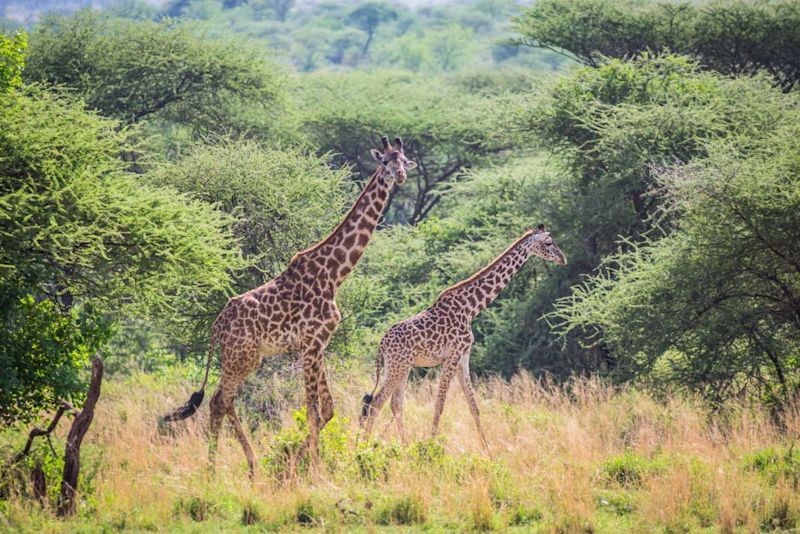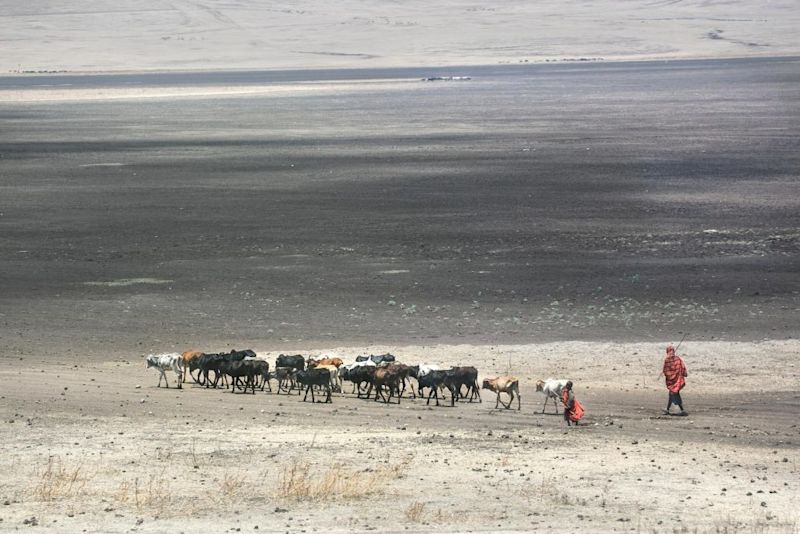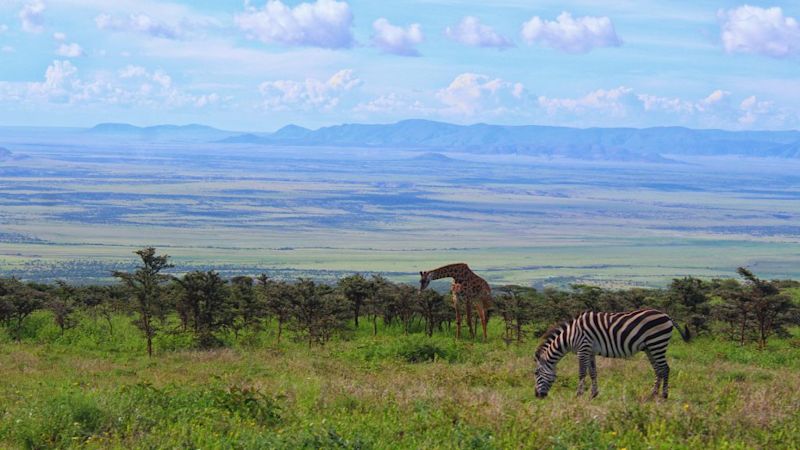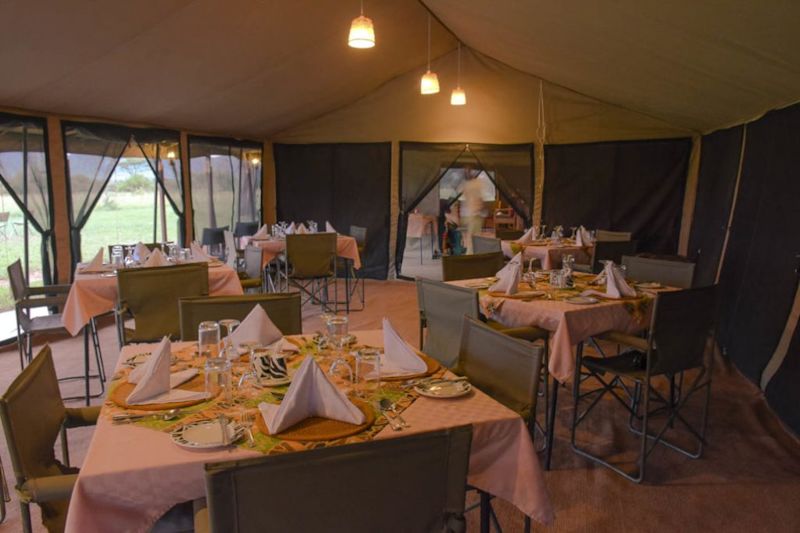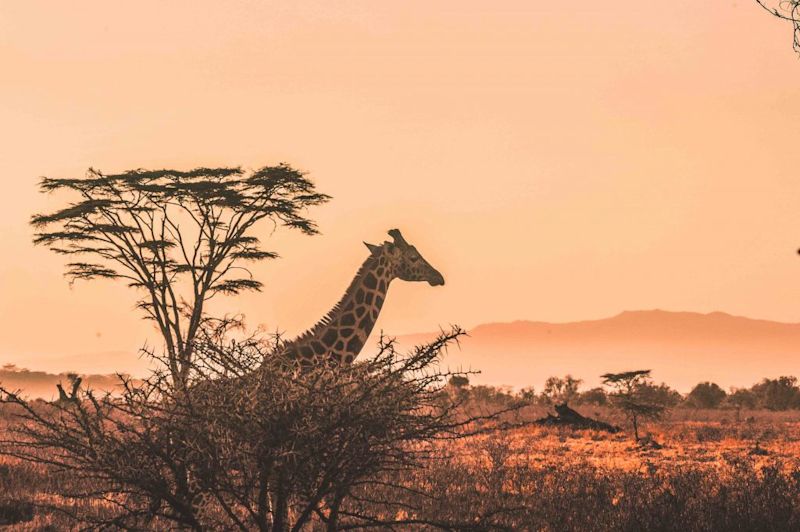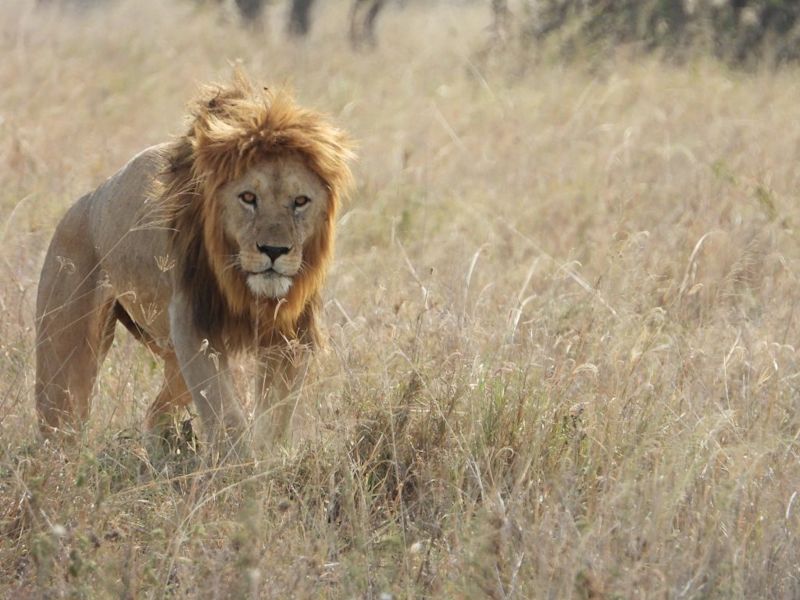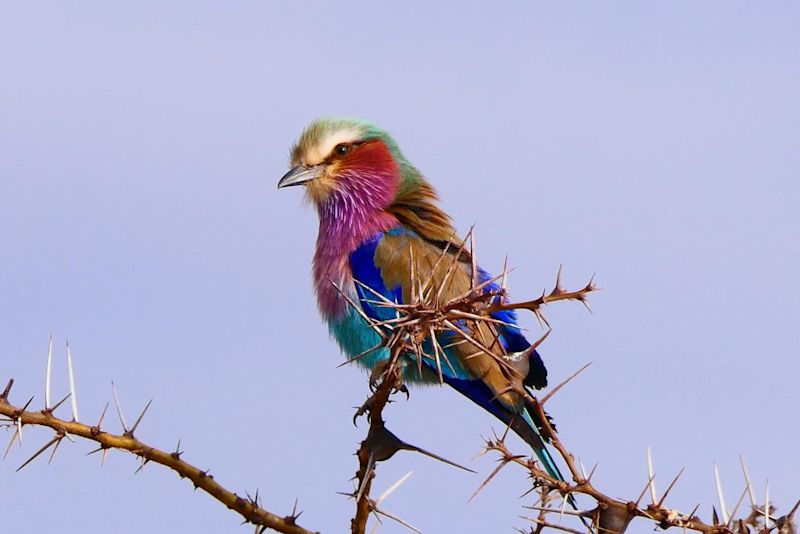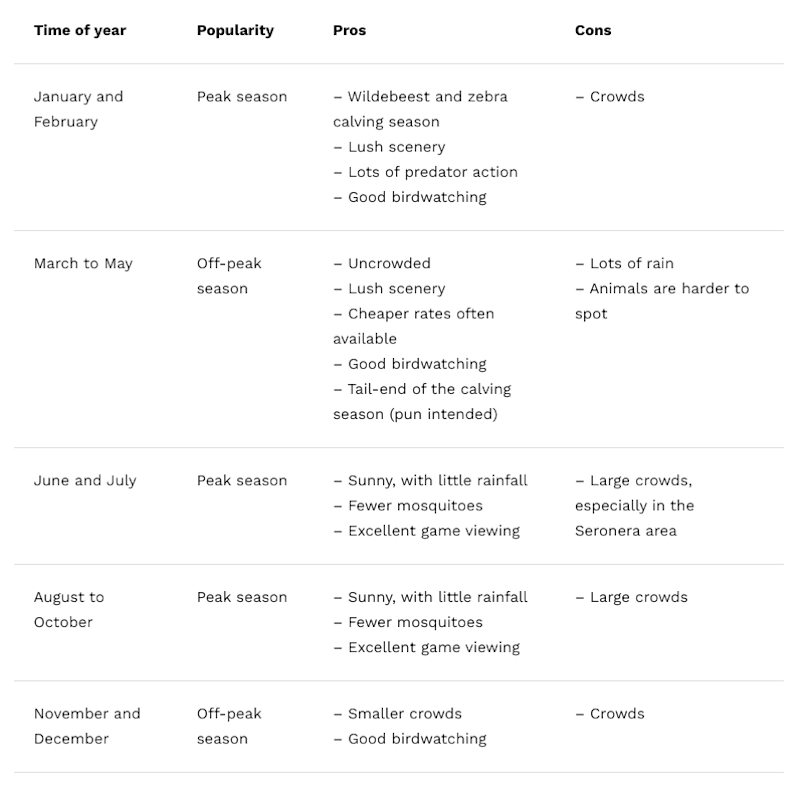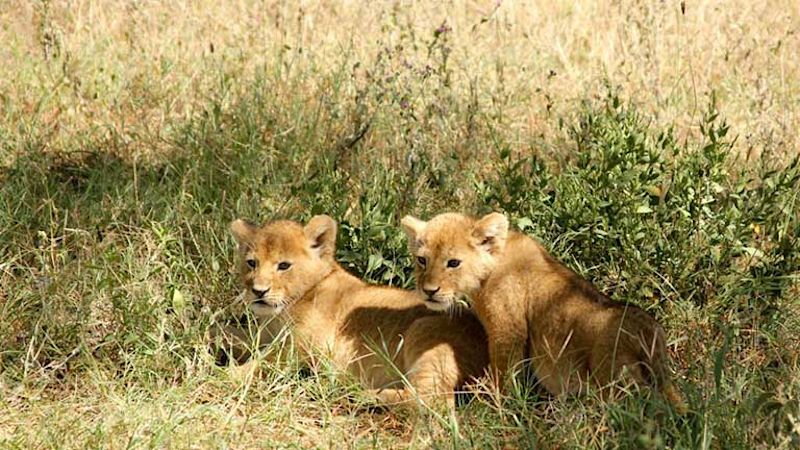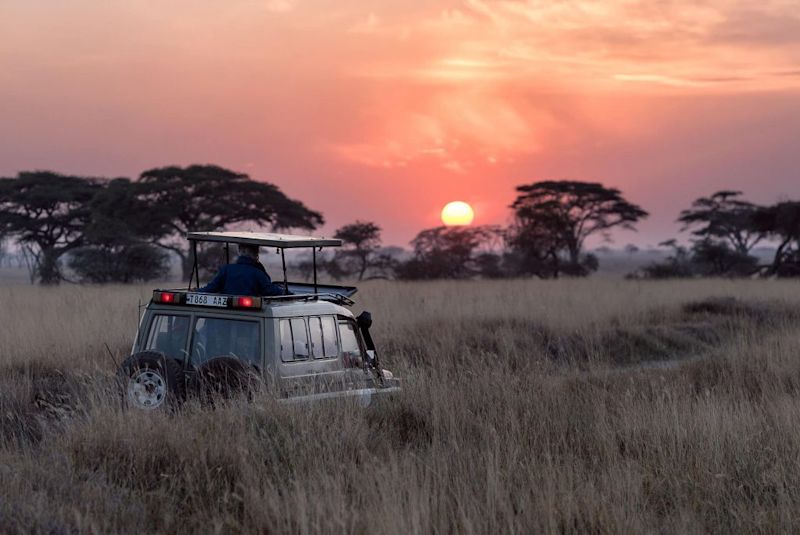To plan a Serengeti trip, you need some basic information. You need to know how to get there, if you should do a self-drive or organised safari, how to be safe, how much it all will cost, and when in the year is the best time to go. With that in mind, we share with you all you need to know to plan an epic Serengeti safari.
A lioness takes it easy on a fallen tree
Where is Serengeti National Park?
Serengeti National Park is in the far north of Tanzania, a country in East Africa.
The park itself borders both Ngorongoro Conservation Area to the east and southeast, and Maswa Game Reserve to the south. To the north is the border with Kenya. The western arm of the park is not far from Lake Victoria. The park is two to four degrees south of the Equator, so temperatures don’t vary much throughout the year.
Map showing popular game reserves in northern Tanzania
Serengeti National Park map
The map of Serengeti National Park below gives an indication of how immense this park actually is. The local Maasai people call the region Serengiti, which means ‘land of the endless plains’. The park isn’t however all plains – there's also riverine forest, shrubs, woodland, wooded grassland, wetland and more.
Map of Serengeti National Park in northern Tanzania
The Serengeti National Park is divided into five sections: north, east, south, west and central.
Seronera Airport in Central Serengeti is the most popular section of the park, with many accommodation options existing here.
There are five gates to the park, one of which is on the border with Ngorongoro Conservation Area, another amazing park that's very much worth visiting.
Did you know that the name Serengeti comes from the Maasai word for 'land of endless plains'?
A lone tree and thunderstorm make for a dramatic scene in the Serengeti
How do I get to Serengeti National Park?
The two main ways to get to Serengeti National Park are by car or plane. There is no rail service.
Driving to Serengeti National Park
Most people driving to Serengeti set off from the city of Arusha in northeast Tanzania (please see the map above). If you’re coming from Kilimanjaro (many opt for a Tanzania safari following on from their Kilimanjaro climb), Moshi will be your staging post (a little east of Arusha, also shown on the map).
The drive west from Arusha to Serengeti takes about seven hours, and you must pass through Ngorongoro Conservation Area. (If you're coming from Moshi, add an hour to your drive time.) Ngorongoro Crater is a massive and beautiful caldera (collapsed volcano) filled with wildlife, so we highly recommend you include a stopover there in your travel itinerary.
If driving from Arusha to Serengeti National Park on your own, be sure to do some careful homework beforehand. You should carry extra fuel, for instance, as the gas stations along the route don’t always have supply.
Further, you should note that:
- you must drive on the left
- cellphone reception is rare along the route
- vehicle recovery can take days, even weeks.
Most tour operators offering Serengeti safaris organise your transport from Arusha for you.
You drive past Ngorongoro Crater (shown here) on your way to and from Serengeti National Park
Flying to Serengeti National Park
There are daily flights from Kilimanjaro Airport in Arusha to both Seronera Airport in central Serengeti National Park and Kirawira B Aerodrome in the western section of the park.
If you’re not already in or near Arusha, you can get a connecting flight there from Dar es Salaam on the coast of Tanzania (near to Zanzibar) or Nairobi in Kenya. (Note that Tanzania requires you to present a yellow fever vaccination certificate if you enter from a country that has a yellow fever risk, such as Kenya.)
Ranger homes within the vast Serengeti National Park
What is the park's entrance fee?
Visitors to Serengeti National Park must pay a per day fee to be in the park.
At present, this fee is $60 per person per day for all foreigners over the age of 16. But beginning 1 July 2021, foreigners over the age of 16 staying in the park must pay:
- $60 in off-peak season (15 March to 15 May)
- $70 in peak season (16 May to 14 March)
An accommodation surcharge
Every individual staying at an hotel accommodation within Serengeti National Park must pay an additional fee per person per night. Please note this is a surcharge fee levied by Serengeti National Park, so it isn't covered by your accommodation fee.
At present, this fee is $50 per person per night for all foreigners over the age of 16. Beginning 1 July 2021, foreigners over the age of 16 staying in the park must pay:
- $50 per person per night from October to June
- $60 per person per night from July to September
It's not all open plains in Serengeti National Park - there's also riverine forests as well as other diverse and gorgeous habitats
Let's now talk about how to plan your game drives ...
Can I self-drive in Serengeti National Park?
Yes, you can do a self-drive safari in Serengeti National Park. That said, we don’t advise it. We have our reasons for saying this …
A 4x4 is needed to drive inside Serengeti
You need a good 4x4 to travel inside of Serengeti, and you also need to be skilled at driving it, as the park’s roads are rutted and rough. Remember that you can’t expect a speedy, city-style assist if you breakdown inside Serengeti! It’s therefore very important to travel in a well-serviced off-road vehicle that’s up to the rigours of the terrain.
While you can hire a 4x4 in Arusha, should something go wrong with the vehicle en route to Seregenti or inside the park that you’re unable to address yourself, your holiday could be put in jeopardy. For this reason we recommend travelling with a tour operator like Follow Alice so that you have proper support and vehicle backup should anything happen. Further, it’s helpful to be driven by someone who knows the park and its road network.
Only tough off-road vehicles can handle the rough and varied terrain of the Serengeti
Tourists don’t know the best places to look for animals
The Serengeti National Park is an immense 14,750 km² (5,695 mi²). While you’ll certainly see animals no matter which section you visit or which direction you head, if you’re particularly keen to see certain animals, like lion prides and rhino crashes, then you need a plan.
One obvious plan is going on safari with an experienced driver-guide. Driver-guides know the behaviours and habitats of the various animals of the Serengeti. They know the favourite watering spots per season, the paths of migratory herds, the birds to look for in the trees, the meanings of different animal tracks, the best spots for lunch, and so much more.
Safari guides are also in communication with park officials and can access the latest on animal positions. So a driver-guide is your very best shot at seeing the Big Five and other fan favourites.
To spot difficult-to-find animals like leopards, it's super useful to have a trained safari guide
Tourists don’t always know what they’re seeing
Finally, a proper driver-guide has knowledge about the animals, their habitats and habits that can raise your safari experience to a whole new level. For instance, the uninformed visitor might see elephants rolling in the mud and assume they’re playing. A driver-guide can relate that they are, in fact, doing this to keep cool and also protect themselves from the sun and insect bites.
Further to this, visitors often don’t know the names of many of the animals that they see. Could you identify a caracal? Bat-eared fox? Buzzard? We all like to know what we’re looking at, and so a well-trained safari driver-guide is key on safari. And not only do these folks know their stuff, but witnessing their passion for the animals and the ecosystem is also an important part of a good Serengeti safari.
If you take our advice and opt to use the services of a tour operator when visiting Serengeti National Park, the next logical question is: how do I go about finding and choosing a good one?
A spotted hyena in golden grass
How to choose a safari tour operator
When booking a Serengeti safari with a tour operator, how do you distinguish the good companies from the shysters? Here are a few tips for checking on the credibility of a tour operator:
- Browse the website to see that everything is solid and consistent.
- Check for a physical business address in the contact info.
- Compare their prices with those of competitors; if it’s drastically cheaper, check they can explain why.
- Search for independent reviews of their services, not just those on the website (which could be fake).
- Check out their social media platforms and read the comments.
- Assess their communication with you – don’t ignore your gut if it’s saying something is off.
- Finally, you can alway ask for a tax registration number.
Hippos look like they'd have a hard time running, but can actually reach 30 km per hour on land!
6 tips for a great Serengeti safari
Here are some tips for going on safari in Serengeti National Park:
- Always listen to your driver-guide if you have one. He or she knows what’s safe to do and what’s not. Never get out of the vehicle without the all-clear from your driver-guide.
- Bring a decent pair of binoculars. When you spot wildlife a little ways away from you, you’ll want to be able to train your binos on it for a better view.
- For the same reason, a camera with a good zoom is a definite bonus.
- Bring plenty of water, a sunhat, and sunscreen – things can get very hot in the crater, especially in summer.
- Don't forget to bring a good insect repellent.
- Bring a notebook and pen to jot down the names of animals and birds you see. These will be great to have when you’re scrolling through your photos back at home and your memory proves a bit fudgy. It can also help you to remember the names of animals you want to google.
One never gets tired of watching giraffes and their unusual walk
Witnessing the Great Migration
The Great Migration – also known as the Great Wildlife Migration – is the Serengeti's primary boast. It's refers to the never-ending movement of two million wildebeests, zebras and other gazelles in a large, rough loop to find water and pasture to sustain them.
The Great Migration takes place predominantly in Serengeti National Park, though it spills over into neighbouring parks as well as into Amboseli National Reserve in southern Kenya.
While one can go on excellent safaris in many African nations, there's nothing to compare (not even close) with the Great Migration of Tanzania and Kenya. It's the dizzyingly large herds stretched out over kilometres that mesmerise visitors and leave an indelible mark in memory banks.
Around 1.5 million wildebeests take part in the Great Migration
The river crossings
One of the biggest crowd-pleasers of the Great Migration is when herds cross the Grumeti and Mara Rivers in northern Serengeti. These are chaotic moments in which the animals plunge across the waters en masse, hoping to make it to the other side against the odds. And there are some steep odds! A high percentage don't make it out alive, being killed by crocodiles, stampeded to death, or washed away by the current.
If you'd like to time your visit to see the river crossings or another aspect of the Great Migration (like the calving season), please read Best time to visit Serengeti National Park.
The Great Migration is the largest land-based migration in the world, and it's hard to explain the awe it inspires when you're there in the Serengeti and witnessing it for yourself.
Great Migration river crossings are frenetic events
Is Tanzania a safe country to visit?
Yes, Tanzania is a safe country to visit. 🙂 🎉 This is especially true of the remote northern section of the country where we take people to climb Kilimanjaro and go on a Northern Circuit safari.
In fact, as we discuss in Kenya vs Tanzania – which offers the better safari?, one of the reasons we choose to take people to see the Great Migration in Tanzania and not Kenya (these are the only two countries where you can see it), is that the former is the safer country.
Most people visiting the Serengeti travel there via the city of Arusha in northern Tanzania
Is Serengeti National Park safe?
Yes, Serengeti National Park is safe. Hundreds of thousands of tourists visit the park every year, making security a top priority for park officials. The greatest danger arguably comes from tourists being, well, silly. Don’t decide you want an Insta pic of you cuddling an itty-bitty lion cub, for instance. Much of the wildlife of Africa is dangerous, and needs to be respected and enjoyed from an appropriate distance. Again, a safari driver-guide is invaluable in keeping visitors to Serengeti National Park safe. You should always, always do as he or she advises.
The Maasai are allowed to move freely with their cattle through Tanzania's northern parks
Is it safe to go on safari?
Yes, it's perfectly safe to go on safari, provided you know what you're doing! The people who get into trouble on safari (like get their vehicles stuck in a rut or are attacked by animals) are usually those lone safari-goers who don't know anything about safari safety.
We recommend travelling with a reputable safari operator when venturing out into Serengeti National Park. Remember, this is a vast park, and it contains plenty of dangerous wildlife. A certified safari driver-cum-guide is the best way to ensure a safe (and rewarding) Serengeti experience.
A safari is very safe so long as you stay within your vehicle and go with somebody who knows what they're doing.
For more info on safari safety, please read Safari safety tips (not just for dummies).
A well-groomed baboon surveying his turf
Serengeti accommodation
Visitors to Serengeti National Park usually stay within the park itself. Fortunately there are numerous and varied accommodations on offer, which makes it likely that you’ll be able to find one that suits your needs and budget. It also means there’s always room for last-minute travellers. Accommodation within Serengeti includes tented camps, chalets, B&Bs, lodges and hotels. You can go minimalist, opting for a campsite with communal facilities, or ultra luxurious, opting for a hotel with a swimming pool, laundry service and other such niceties.
Note that off-season accommodation is generally cheaper than peak accommodation. As mentioned, peak seasons are January to March (calving season) and June to October (the dry season).
A good view showing why the Serengeti is called the 'land of endless plains'
Mobile camps
During migration season there are also mobile camps known as Great Migration camps. These are moving campsites that follow the movements of the wildebeests. Such setups essentially guarantee guests that they’ll enjoy multiple herd sightings. Great Migration camps are understandably more expensive than stationary camps, and cost around $400 (€365) per person per night.
Choosing accommodation
Over the years we’ve found that many would-be safari goers to the Serengeti start to feel overwhelmed by the volume of accommodation choices on offer. It’s hard to know when simply browsing on the internet which establishments offer good value and actually live up to their claims. This is when a tour operator is so useful, as they know the different offerings and can make informed recommendations.
At Follow Alice we put our guests up at ThornTree Camp, which is in the central Seronera portion of the park. ThornTree Camp offers glamping accommodation, making it both an affordable and comfortable option. We also feel that there’s just something special about camping in Africa! Further, we find that situating ourselves in the central part of Serengeti is useful as it makes all areas of the park reasonably accessible.
We usually stay at ThornTree Camp when visiting central Serengeti
Best time of year to visit the Serengeti
You can visit Serengeti National Park at any time of the year and have an epic safari. The park is a rich ecosystem with millions of large animals, so you don’t have to worry that you’ll somehow ‘miss’ the animals! That said, peak seasons in the Serengeti are January to March and late June to October, for different reasons.
Below we give an overview of the pros and cons of each season when it comes to visiting the Serengeti. If you'd like a more comprehensive breakdown, however, please read Best time to visit Serengeti National Park, in which we discuss what to expect each month of the year.
Giraffes are only found in Africa and are a truly iconic sight
Peak season: January to March
January to March is calving season for the wildebeests, zebras and other antelopes. There’s plenty of predator action going down. On top of this, the scenery is green and pretty.
Peak season: June to October
June to October is the main peak season. This is the dry season in Serengeti, which has a few advantages, namely:
- There’s little rain and plenty of sun, so your precious game-viewing days shouldn’t be compromised.
- There are fewer mosquitoes, which reduces your chances of contracting malaria (and also buzzing mozzies are super annoying!).
- Animal spotting is easier as not only is the vegetation sparser but the animals also congregate near rivers and watering holes.
June to October is also the time of year when the Great Migration is in full swing and visitors are rewarded with glorious vistas of millions of wildebeest and other antelope crossing the plains in search of water and grazing lands. During June and July the wildebeest migration takes place mostly in the west of the park. In August and September it moves to the north of the park.
Note that peak seasons can result in some very real jeep traffic in certain parts of the park, especially when there’s a particularly exciting animal sighting. Sometimes this scares off the animals, so only the first to arrive on the scene get to see them. But again, the park is immense, so you can always head to the more isolated parts if you wish to have a more solitary safari.
The shorter, brown grasses of the dry season make animals easier to spot
Birdwatching season: November to May
November to May is the best season in terms of birdwatching, as many migratory birds from North Africa and Europe are present at this time. And many are decked out in their breeding plumage.
If you’re adding a Serengeti safari onto another adventure like a Kilimanjaro climb, consider which time of year is best for both adventures.
The lilac-breasted roller is one of our all-time favourite Tanzanian birds
Summary of Serengeti seasons
Below we summarise the pros and cons of going on safari in Serengeti National Park at different times of the year. Hopefully this will help you settle on a month to visit the Serengeti that best suits your needs and preferences. Just remember that game spotting is good at Serengeti all year round!
Lion cubs are sometimes just too adorable
Did you know that safari is the Swahili word for ‘journey’ or ‘trip’?
Tipping in Serengeti National Park
Tipping is an important part of service culture in Tanzania. Tanzanian salaries tend to be very low, so staff rely on tips to supplement their income.
Those working in and around Serengeti National Park are no different. As a rough guide to help you with budgeting, consider giving a $20 to $30 tip to your safari driver-guide per day of service. Obviously anything above that, especially if the service was good, is greatly appreciated.
Consider tipping accommodation staff $15 per person per day. And when eating out, tipping 10% is the norm.
It's customary to tip your safari guide
Things to do near Serengeti
Some of the attractions near or even directly next to Serengeti National Park that are very much worth adding to your safari trip are:
- Lake Manyara National Park, a beautiful game reserve centred on its eponymous lake.
- Ngorongoro Crater, a caldera whose steep walls have created a unique wildlife haven.
- Olduvai Gorge, a 48 km-long gorge that’s known for its sisal plants and paleo-anthropological (human evolutionary) importance.
- Lake Eyasi, a salt lake in the Rift Valley with a gorgeous, mountainous shoreline.
- Lake Victoria, the staggeringly large and most famous of the Rift Valley lakes.
- Mount Kilimanjaro, Africa’s highest mountain which can be climbed without any mountaineering experience.
Keen for a challenge? It might be time to strap on your boots and climb Mt Kilimanjaro!
Time to visit Serengeti National Park?
If you're interested in a Serengeti safari – and we can't see how you wouldn't be! – then please feel free to get in touch with any questions you may have. We're always happy to chat via email, Skype or WhatsApp and share our insights with you. A Serengeti safari is a truly unbeatable experience that will stay with you for the rest of your life. We cannot recommend it enough!
